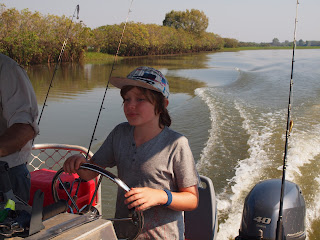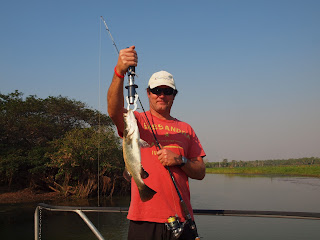Litchfield was one of our favourite places because we had so much fun swimming and jumping into the waterholes here. The caravan park (Litchfield Tourist Park) we stayed in had a good pub/restaurant and friendly staff (and they had buffalo ice cream!) There is water in the falls and waterholes at Litchfield National Park all year round as the sandstone in this area is very absorbent, capturing water during the wet season and slowly releasing water thoughout the year. There are crocodiles but the safe swimming holes are well marked.
Termite mounds
 |
| A cemetery of magnetic termite mounds. |
 |
| A cathedral termite mound |
Wangi Falls
Wangi falls is the most accessible and popular falls in Litchfield. It is beautiful but because it is easy to access there were many, many people swimming and picnicing there.
Blythe Homestead, Sandy Creek, Tjaynera Falls
It is worth following the 4WD track out to all these places just to see the landscape and cross the wide creek crossings, but there are more treasures to be found here.
 |
| Blythe Homestead |
As we crossed the creek on our way back to the road from Blythe Homestead we saw a small (maybe 1-2 year old) crocodile swimming downsteam. We had to slow a little to let it pass. Neil had previously told me that you should never drive across water that you wouldn't walk through...hmmmm!?
 |
| Hiking along Sandy Creek |
We hiked along Sandy Creek to find the falls. Most of the hike was in the shade but it was very hot. We saw a few people heading out as we hiked in. Our reward was having the Tjaynera falls to ourselves. We were able to swim to the waterfall and climb up and sit on the rocks. The best part was, no-one else arrived until we were just packing up to leave, then we saw several small groups heading in!
 |
| The reward at the end of the hike Tjaynera Falls |
 |
| The snake Maddi poked with the toe of her thong, thinking it was just a skin as we walked back up the path. Luckily it wasn't offended! |
Tjaetaba Falls
It was a bit of a hike to the top of the Tjaetaba Falls. It was hot and we were feeling rather sweaty; hoping it would be worth the effort. Liam was quite unhappy about having to walk and keeping him motivated was a bit of a challenge. When we finally got there we could only get a bit of a view of the actual falls. The pool below the falls was sacred to the indigenous people of the area so everyone was asked to swim only in the pool at the top.
When we looked at the rockpool we were unsure how to get in. It was deep and quite a big step down into the pool from the side you approach. The other side was the big drop - the falls. Finally I figured out where to get in. Maddi was a bit nervou about getting in as she had seen a Merton's Water Monitor going in and out of the water. When I got in it stayed on the side and didn't budge until much later when it realised I was looking straight at it. Then it climbed up the falls and swam off up the creek.
 |
| Liam jumping into the rock pool above the Tjaetaba Falls. |
We also enjoyed swimming at the Buley Rockholes and F Falls. Unfortunately we ran out of batteries on our main camera, and then I managed to misplace the other camera which we used as a back up so no photos of these. I wish I could have taken photos of Neil doing horsey bombs into the Buley Rockholes. He nearly washed us over the fall into the lower rockhole!






































































